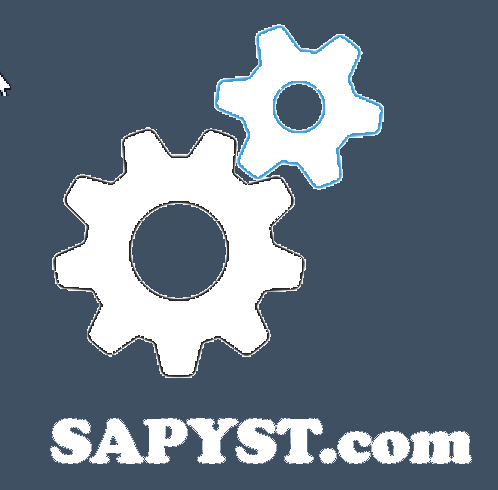What is SAP?
SAP AG is a German software company whose initials at first stood for Systemanalyse und Programmentwicklung (System Analysis and Programs development). But later their meaning changed to Systeme, Anwendungen und Produkte in der Datenverarbeitung (Systems, Applications, and Products for the Data Process).
Normally, when somebody talks about SAP, he is talking about its star product, an ERP that is worldwide spread, especially in big companies. This one has been named in different ways as it evolved: R/1, R/2, R/3, ECC, and finally S/4 HANA.
The rest of the products of this company are mainly functional extensions of this ERP, in the supply chain (for instance easing the interaction with Vendors and Customers) or adding new industry-specific versions (Retail, Media, Oil, …).
The Company
In 1972 five former IBM employees founded the company SAP with the vision of developing a standard software application to support all business processes in real-time.
At first, it was focused on the account and financial functionality, which was launched a year later with the R/1 release. Later on, in 1979 it was launched R/2. Newly added functionality gave birth to the release R/3 in 1992. In 2004 it launched the ECC version with some improvements and finally, in 2010 it launched S/4 HANA, based on a new database concept (HANA).
Since the beginning, the growth has been constant, in offered functionality, in the number of implementations, and in geographical scope.
In 1998 SAP AG went live in Frankfurt and Stuttgart exchanges. In 1995 it was included in the German index DAX and in 2003 in the Dow Jones Stoxx 50.
In addition to the software development and sales, SAP supports a wide structure for giving support to all active implementations and for giving training to consultants and developers that help its customers.
Products
Although as commented above, SAP S/4 HANA (ERP Central Component) is the star product, there are other products that complement it or that are focused on a specific segment or industry.
SAP AG organizes its products in the following categories:
- ENTERPRISE RESOURCE PLANNING
- SAP S/4 HANA Cloud
- FINANCIAL MANAGEMENT
- ERP for Small and Midsize Enterprises
- Financial Planning and Analysis
- Accounting and Financial Close
- Treasury Management
- Accounts Receivable, Billing, and Revenue Management
- Governance, Risk, Compliance (GRC), and Cybersecurity
- CRM AND CUSTOMER EXPERIENCE
- SAP Customer Experience Solutions
- Customer Data
- Marketing
- Commerce
- Sales
- Service
- SPEND MANAGEMENT
- Supplier Management
- Sourcing and Contracts
- Procurement
- Invoices and Payments
- Services Procurement and External Workforce
- Travel and Expense
- SUPPLY CHAIN MANAGEMENT
- Supply Chain Planning
- Supply Chain Logistics
- Manufacturing
- Product Lifecycle Management
- Enterprise Asset Management
- HR AND PEOPLE ENGAGEMENT
- Employee Experience Management
- Core HR and Payroll
- Talent Management
- HR Analytics and Workforce Planning
- BUSINESS TECHNOLOGY PLATFORM
- Application and Development and Automation
- Extended Planning and Analysis
- Data and Analytics
- Integration
- Artificial Intelligence
In fact, some of these solutions are part of the ERP Solution. They can be implemented isolated or integrated with the rest of them. What is the main advantage of this approach, avoiding creating custom interfaces among different systems.
As different industries have different requirements, SAP AG also offers some industry-specific functionality:
- ENERGY AND NATURAL RESOURCES
- Building Products
- Chemicals
- Mill Products
- Mining
- Oil, Gas, and Energy
- Utilities
- SERVICE INDUSTRIES
- Cargo Transportation and Logistics
- Engineering, Construction, and Operations
- Media
- Passenger Travel and Leisure
- Professional Services
- Sports and Entertainment
- Telecommunications
- CONSUMER INDUSTRIES
- Agribusiness
- Consumer Products
- Fashion
- Life Sciences
- Retail
- Wholesale Distribution
- DISCRETE INDUSTRIES
- Aerospace and Defense
- Automotive
- High Tech
- Industrial Manufacturing
- FINANCIAL SERVICES
- Banking
- Insurance
- PUBLIC SERVICES
- Defense and Security
- Federal and National Government
- Future Cities
- Healthcare
- Higher Education and Research
- Regional, State, and Local Government
These solutions maintain many of the common functionalities. But in the areas where these industry processes differ from the rest, they incorporate new functionality to ease their management.
It is not necessary to implement all their functionality. Normally only some parts of it are implemented.
The first phase in an SAP implementation project consists precisely in identifying those processes not covered by the standard SAP or specific SAP solutions. This is called the GAP analysis.
In this step, the implementation team will decide which of these functionalities will be implemented, for which a process reengineering will be necessary and for which a customized program will have to be developed.
Also, in this step, it must be defined the implementation scope. Stating which processes will be covered in SAP and which ones will be maintained outside of this ERP.

Recent Comments